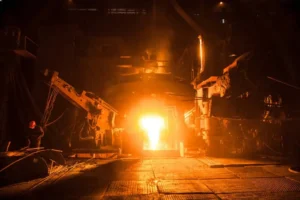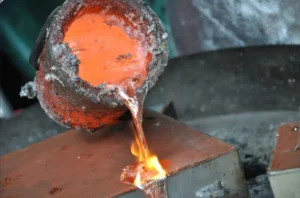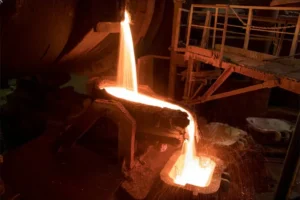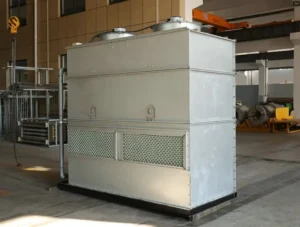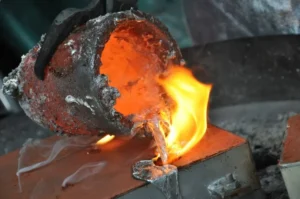Trong quá trình luyện kim loại, Deslagging (Loại bỏ xỉ) là một hoạt động cực kỳ quan trọng nhưng cũng đầy thử thách. Kỹ thuật khử xỉ hiệu quả không chỉ nâng cao đáng kể độ tinh khiết của kim loại bằng cách loại bỏ các tạp chất có hại mà còn kéo dài tuổi thọ của lớp lót vật liệu chịu lửa lò, từ đó giảm chi phí sản xuất và đạt được quy trình luyện kim hiệu quả và bền vững hơn. Bài viết này cung cấp sự khám phá chuyên sâu về các chất tạo xỉ và phương pháp khử xỉ khác nhau, và giải thích cách đạt được sự cân bằng giữa việc loại bỏ tạp chất hiệu quả và việc bảo vệ lớp lót chịu lửa.
Ⅰ. Hình thành xỉ chính xác: Bước đầu tiên để loại bỏ tạp chất hiệu quả
Mục tiêu chính của việc hình thành xỉ là đưa vào các chất trợ dung (chất xỉ) phản ứng với oxit, lưu huỳnh, phốt pho, và các tạp chất khác trong kim loại nóng chảy. Phản ứng này tạo thành xỉ có điểm nóng chảy thấp và mật độ thấp không thể trộn lẫn với kim loại nóng chảy, cho phép nó nổi lên bề mặt để loại bỏ tiếp theo. Lựa chọn chất xỉ thích hợp là điều kiện tiên quyết để khử xỉ thành công.
Các tác nhân xỉ phổ biến và chức năng của chúng
| Loại chất xỉ | Thành phần chính | Chức năng chính |
| Vôi/đá vôi | canxi oxit (CaO) | Tăng tính bazơ của xỉ để loại bỏ hiệu quả các tạp chất có tính axit như phốt pho (P) và lưu huỳnh (S). Nó là chất xỉ được sử dụng rộng rãi nhất. |
| Dolomit | Canxi-Magiê Oxit (CaO·MgO) | Bên cạnh khả năng khử lưu huỳnh và khử phospho, nó cung cấp oxit magiê (MGO) để bảo vệ lớp lót chịu lửa gốc magiê và làm chậm sự xói mòn. |
| Fluorit | Canxi Fluoride (CaF₂) | Dòng chảy mạnh làm giảm đáng kể điểm nóng chảy của xỉ và tăng tính lưu động của xỉ, thúc đẩy phản ứng khử lưu huỳnh và khử phospho. |
| silic | điôxít silic (SiO₂) | Tăng độ axit của xỉ, chủ yếu được sử dụng khi cần loại bỏ các oxit cơ bản (như oxit sắt). |
| Xỉ tổng hợp | Hỗn hợp các oxit và chất trợ khác nhau | Được xây dựng trước cho các loại hoặc điều kiện thép cụ thể, cho phép thực hiện nhiều chức năng như hình thành xỉ nhanh chóng, tạo bọt, và hấp thụ tạp chất. |
Chìa khóa để hình thành xỉ hiệu quả nằm ở việc kiểm soát quá trình “tính cơ bản.” Tính bazơ của xỉ (thường được biểu thị bằng tỷ lệ CaO/SiO2) là một chỉ số quan trọng về tính chất hóa học của xỉ.
- Xỉ có tính bazơ cao (>1): Thuận lợi cho việc loại bỏ phốt pho và lưu huỳnh, nhưng có thể có tính lưu động kém và có tính ăn mòn đối với lớp lót chịu lửa có tính axit.
- Xỉ có tính bazơ thấp (<1): Có tính lưu động tốt nhưng kém hiệu quả hơn trong việc loại bỏ phốt pho và lưu huỳnh, và hung hăng đối với lớp lót chịu lửa cơ bản.
Vì thế, trong quá trình luyện kim, thành phần chất tạo xỉ phải được điều chỉnh linh hoạt dựa trên thành phần kim loại được gia công, tạp chất mục tiêu, và vật liệu chịu lửa để đạt được tính bazơ và tính lưu loát lý tưởng của xỉ.
Ⅱ. Giảm xỉ thông minh: Nghệ thuật cân bằng sự tinh khiết và bảo vệ
Khi xỉ đã hình thành và hấp thụ hoàn toàn các tạp chất, Thách thức cốt lõi của hoạt động loại bỏ xỉ là làm thế nào để loại bỏ nó một cách hiệu quả và triệt để đồng thời giảm thiểu sự xáo trộn đối với kim loại nóng chảy và làm hỏng lớp lót chịu lửa.
Các phương pháp khử xỉ phổ biến
- Cào thủ công:
- Phương pháp: Người vận hành dùng cào có cán dài tự tay kéo xỉ nổi từ cửa lò vào nồi xỉ.
- Ưu điểm: Linh hoạt, yêu cầu thiết bị đơn giản, và thích hợp cho các lò nung nhỏ hoặc loại bỏ xỉ cục bộ.
- Nhược điểm: Cường độ lao động cao, độ an toàn thấp, kết quả phụ thuộc nhiều vào kinh nghiệm của người vận hành, thường dẫn đến mất kim loại, và có thể không đầy đủ.
- Đọc lướt cơ học:
- Phương pháp: Sử dụng máy khử xỉ chuyên dụng có đầu cào hoặc lưỡi cào ở cuối cánh tay kéo dài vào trong lò. Chúng có thể được điều khiển bằng khí nén hoặc thủy lực.
- Ưu điểm: Mức độ tự động hóa cao, tốc độ khử xỉ nhanh, vận hành an toàn hơn, và làm giảm đáng kể cường độ lao động.
- Nhược điểm: Đầu tư ban đầu cao hơn, yêu cầu cụ thể cho thiết kế lò, và chi phí bảo trì cao hơn cho cánh tay cơ khí.
- Nghiêng và đổ:
- Phương pháp: Lò nghiêng để đổ kim loại nóng chảy từ lỗ vòi, trong khi xỉ có mật độ thấp hơn được giữ lại bởi đập xỉ, bóng xỉ, hoặc bị cào ra khỏi cửa xỉ riêng.
- Ưu điểm: Thích hợp cho bộ chuyển đổi lớn và EAF, cho phép tách nhanh khối lượng lớn xỉ và thép.
- Nhược điểm: Yêu cầu công nghệ chặn xỉ hiệu quả cao; hoạt động không đúng cách có thể dẫn đến “xỉ mang theo,” làm ảnh hưởng đến độ tinh khiết của thép nóng chảy.
- Hút nước/Chân không Khử xỉ:
- Phương pháp: Một ống siphon làm bằng vật liệu chịu lửa được đưa vào lớp xỉ, và dùng chân không để hút xỉ ra ngoài.
- Ưu điểm: Loại bỏ xỉ cực kỳ triệt để mà hầu như không gây tổn thất kim loại, mang lại độ tinh khiết kim loại rất cao.
- Nhược điểm: Thiết bị phức tạp và chi phí bảo trì cao; chủ yếu được sử dụng trong quá trình tinh luyện các hợp kim đặc biệt hoặc các loại thép có yêu cầu chất lượng nghiêm ngặt.
- Xả khí hỗ trợ khử xỉ:
- Phương pháp: Trong khi khử xỉ, một loại khí trơ (như argon) được thổi vào bể nóng chảy thông qua gạch thấm ở đáy hoặc tường lò. Tác dụng khuấy trộn của khí đẩy xỉ nổi về phía cửa xỉ, tạo điều kiện cho việc loại bỏ nó.
- Ưu điểm: Loại bỏ xỉ hiệu quả từ “vùng chết,” nâng cao hiệu quả và tính đầy đủ của quá trình khử xỉ.
- Nhược điểm: Yêu cầu hệ thống cung cấp khí bổ sung và có thể làm giảm nhiệt độ nhẹ trong kim loại nóng chảy.
Ⅲ. Bảo vệ lớp lót chịu lửa: Chiến lược cốt lõi để kéo dài tuổi thọ dịch vụ
Sự xói mòn lớp lót vật liệu chịu lửa là một quá trình hóa lý phức tạp được thúc đẩy bởi ba yếu tố chính: ăn mòn hóa học, mài mòn vật lý, và sự nứt vỡ nhiệt.
Cơ chế chính của xói mòn vật liệu chịu lửa
- Ăn mòn hóa học: Đây là nguyên nhân gây xói mòn nghiêm trọng nhất. Một số thành phần trong xỉ (ví dụ., FeO, SiO2) phản ứng hóa học với các oxit cơ bản của lớp lót chịu lửa (ví dụ., MGO, CaO), hình thành các hợp chất có điểm nóng chảy thấp làm cho vật liệu lót tan chảy và phân hủy. Ví dụ, xỉ axit chứa SiO2 sẽ ăn mòn lớp lót gạch magie-cacbon bazơ.
- mài mòn vật lý: Dòng chảy của kim loại nóng chảy và xỉ tạo ra sự cọ rửa và mài mòn liên tục trên lớp lót, đặc biệt là ở cửa sạc, lỗ vòi, và dòng xỉ.
- Tách nhiệt: Sự dao động nhiệt độ mạnh mẽ trong chu kỳ nấu chảy gây ra ứng suất nhiệt trong vật liệu chịu lửa. Khi ứng suất này vượt quá cường độ của vật liệu, nó dẫn đến nứt và vỡ.
Các biện pháp hiệu quả để bảo vệ lớp lót chịu lửa
- điều hòa xỉ:
- Tăng MgO Độ bão hòa: Đảm bảo xỉ chứa hàm lượng MgO vừa đủ và bão hòa là cách hiệu quả nhất để bảo vệ lớp lót gốc magie (phổ biến trong EAF và bộ chuyển đổi). Khi xỉ bão hòa MgO, xu hướng của nó “nước rỉ ra” MgO từ lớp lót bị giảm đáng kể. Điều này có thể đạt được bằng cách thêm dolomite hoặc magie nung nhẹ trong quá trình hình thành xỉ.
- Duy trì tính cơ bản hợp lý: Duy trì độ bazơ xỉ tương đối ổn định, vừa phải và tránh biến động mạnh có thể làm chậm tốc độ ăn mòn hóa học trên lớp lót.
- Giảm bớt FeO Nội dung: Hàm lượng FeO quá cao trong xỉ làm tăng tốc độ oxy hóa của vật liệu chịu lửa chứa carbon và sự ăn mòn của lớp lót gốc magie. Điều này có thể được quản lý bằng cách kiểm soát hợp lý quá trình thổi oxy và cân bằng carbon-oxy..
- Xỉ bắn tung tóe:
- Đây là kỹ thuật bảo trì lớp lót chủ động. Sau khi gõ nhẹ vào thép, một lượng nhỏ xỉ được điều chỉnh thành phần được cố ý để lại trong lò.
- Nitơ áp suất cao sau đó được thổi qua ống dẫn oxy để phun xỉ nhớt này đều lên thành lò., tạo thành lớp phủ bảo vệ.
- Cái này “thổi men” cách nhiệt hiệu quả vật liệu chịu lửa khỏi tiếp xúc trực tiếp và ăn mòn bởi thép nóng chảy ở nhiệt độ cao và xỉ của nhiệt tiếp theo, kéo dài đáng kể tuổi thọ của lớp lót. Phun xỉ là công nghệ then chốt để đạt được tuổi thọ vận hành lâu dài trong các bộ chuyển đổi lớn hiện đại.
- Cải thiện hoạt động khử xỉ:
- Vận hành nhẹ nhàng: Tránh tác động mạnh lên lớp lót chịu lửa từ cánh tay xả xỉ cơ học.
- Kiểm soát thời gian xả xỉ: Giảm thiểu thời gian mở cửa lò để giảm tổn thất bức xạ nhiệt và sốc nhiệt cho lớp lót.
- Tránh đọc lướt quá mức: Trong một số trường hợp, để lại một lớp xỉ mỏng được xử lý tốt ở đường xỉ thực sự có thể đóng vai trò như một hàng rào bảo vệ.
Phần kết luận
Khử xỉ hiệu quả không phải là một hoạt động đơn lẻ mà là một hệ thống tích hợp bao gồm độ chính xác sự hình thành xỉ, khử xỉ thông minh, Và chủ động bảo vệ vật liệu chịu lửa. Nó là yếu tố cốt lõi trong việc theo đuổi chất lượng cao của ngành luyện kim hiện đại, chi phí thấp, và tuổi thọ lò dài. Bằng cách lựa chọn và cân đối một cách khoa học các chất xỉ, các đặc tính của xỉ có thể được kiểm soát ngay từ đầu, đặt nền tảng cho việc loại bỏ tạp chất hiệu quả. Bằng cách áp dụng các phương pháp và thiết bị khử xỉ tiên tiến, độ tinh khiết của kim loại có thể được đảm bảo đồng thời giảm tổn thất kim loại và rủi ro vận hành. Phê bình nhất, bằng cách tối ưu hóa tính chất hóa học của xỉ và thực hiện các kỹ thuật tiên tiến như phun xỉ, những gì từng là chất thải có thể được biến thành công cụ bảo vệ lớp lót lò.
Nắm vững và áp dụng các kỹ thuật toàn diện này là chìa khóa để đạt được chiến thắng kép về độ tinh khiết của kim loại được nâng cao và khả năng bảo vệ vật liệu chịu lửa mạnh mẽ, cuối cùng dẫn đến hiệu quả, ổn định, và hoạt động luyện kim tiêu thụ thấp trong một thị trường cạnh tranh.


